RN Evidence-Based Practice: Applying Research to Nursing Care
VerifiedAdded on 2022/09/09
|7
|1321
|22
Essay
AI Summary
This essay delves into the principles and application of evidence-based practice (EBP) within the realm of registered nursing. It emphasizes the significance of EBP in enhancing patient outcomes and improving the quality of care. The paper explores the integration of both quantitative and qualitative research methods, highlighting how they contribute to informed clinical decision-making. It further discusses the sources of evidence that shape nursing practice, including scientific knowledge, intuition, tradition, and personal experience. The essay also covers the core principles of patient-centered care, teamwork, and quality improvement within the context of research ethics and design. Moreover, it addresses the obstacles in implementing EBP, such as data availability and translation into practice, while underscoring the importance of continuous professional growth and the use of research findings to inform action in various healthcare settings. This work underscores the importance of EBP in nursing and offers insights into its multifaceted nature and impact on patient care.
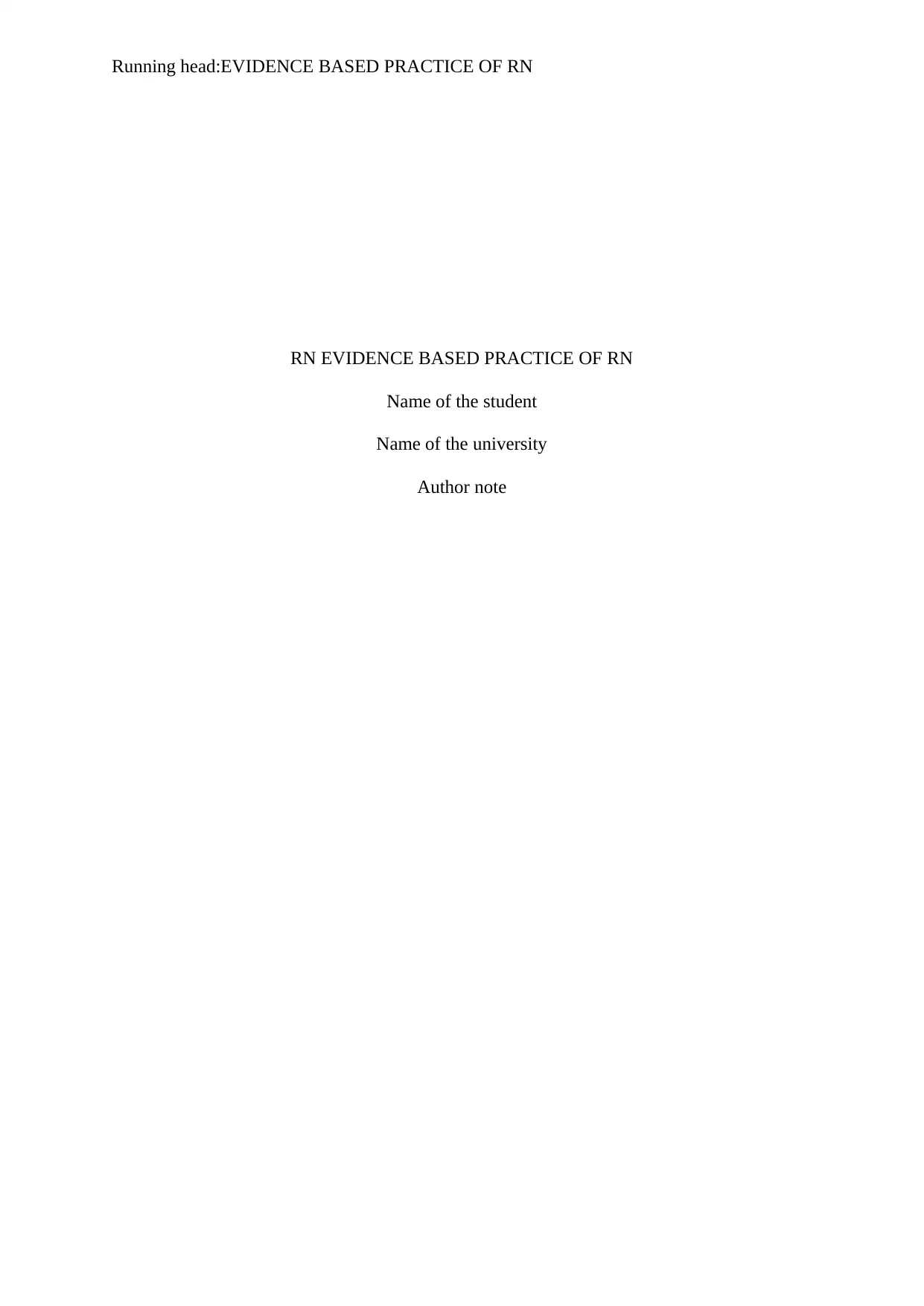
Running head:EVIDENCE BASED PRACTICE OF RN
RN EVIDENCE BASED PRACTICE OF RN
Name of the student
Name of the university
Author note
RN EVIDENCE BASED PRACTICE OF RN
Name of the student
Name of the university
Author note
Paraphrase This Document
Need a fresh take? Get an instant paraphrase of this document with our AI Paraphraser
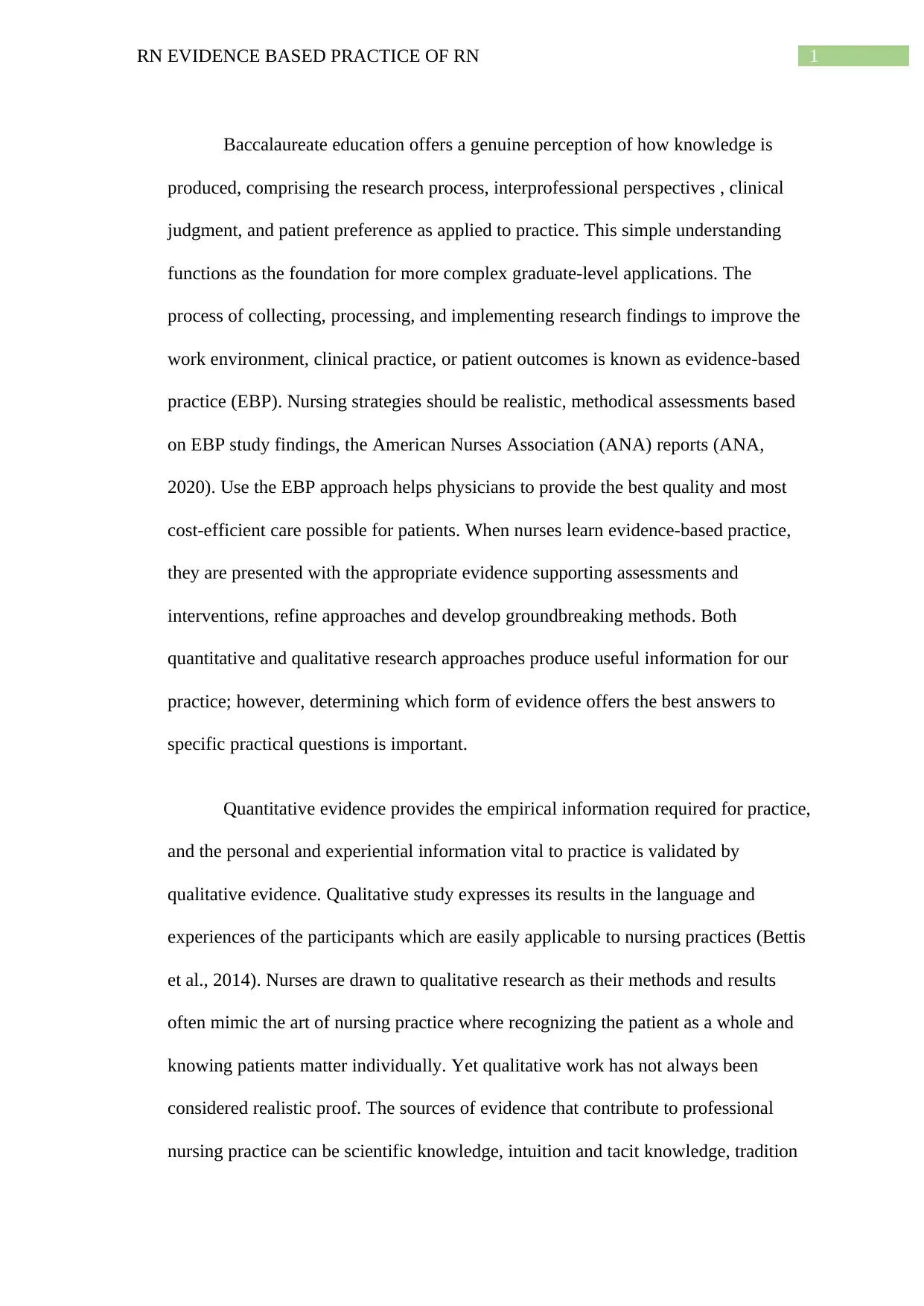
1RN EVIDENCE BASED PRACTICE OF RN
Baccalaureate education offers a genuine perception of how knowledge is
produced, comprising the research process, interprofessional perspectives , clinical
judgment, and patient preference as applied to practice. This simple understanding
functions as the foundation for more complex graduate-level applications. The
process of collecting, processing, and implementing research findings to improve the
work environment, clinical practice, or patient outcomes is known as evidence-based
practice (EBP). Nursing strategies should be realistic, methodical assessments based
on EBP study findings, the American Nurses Association (ANA) reports (ANA,
2020). Use the EBP approach helps physicians to provide the best quality and most
cost-efficient care possible for patients. When nurses learn evidence-based practice,
they are presented with the appropriate evidence supporting assessments and
interventions, refine approaches and develop groundbreaking methods. Both
quantitative and qualitative research approaches produce useful information for our
practice; however, determining which form of evidence offers the best answers to
specific practical questions is important.
Quantitative evidence provides the empirical information required for practice,
and the personal and experiential information vital to practice is validated by
qualitative evidence. Qualitative study expresses its results in the language and
experiences of the participants which are easily applicable to nursing practices (Bettis
et al., 2014). Nurses are drawn to qualitative research as their methods and results
often mimic the art of nursing practice where recognizing the patient as a whole and
knowing patients matter individually. Yet qualitative work has not always been
considered realistic proof. The sources of evidence that contribute to professional
nursing practice can be scientific knowledge, intuition and tacit knowledge, tradition
Baccalaureate education offers a genuine perception of how knowledge is
produced, comprising the research process, interprofessional perspectives , clinical
judgment, and patient preference as applied to practice. This simple understanding
functions as the foundation for more complex graduate-level applications. The
process of collecting, processing, and implementing research findings to improve the
work environment, clinical practice, or patient outcomes is known as evidence-based
practice (EBP). Nursing strategies should be realistic, methodical assessments based
on EBP study findings, the American Nurses Association (ANA) reports (ANA,
2020). Use the EBP approach helps physicians to provide the best quality and most
cost-efficient care possible for patients. When nurses learn evidence-based practice,
they are presented with the appropriate evidence supporting assessments and
interventions, refine approaches and develop groundbreaking methods. Both
quantitative and qualitative research approaches produce useful information for our
practice; however, determining which form of evidence offers the best answers to
specific practical questions is important.
Quantitative evidence provides the empirical information required for practice,
and the personal and experiential information vital to practice is validated by
qualitative evidence. Qualitative study expresses its results in the language and
experiences of the participants which are easily applicable to nursing practices (Bettis
et al., 2014). Nurses are drawn to qualitative research as their methods and results
often mimic the art of nursing practice where recognizing the patient as a whole and
knowing patients matter individually. Yet qualitative work has not always been
considered realistic proof. The sources of evidence that contribute to professional
nursing practice can be scientific knowledge, intuition and tacit knowledge, tradition
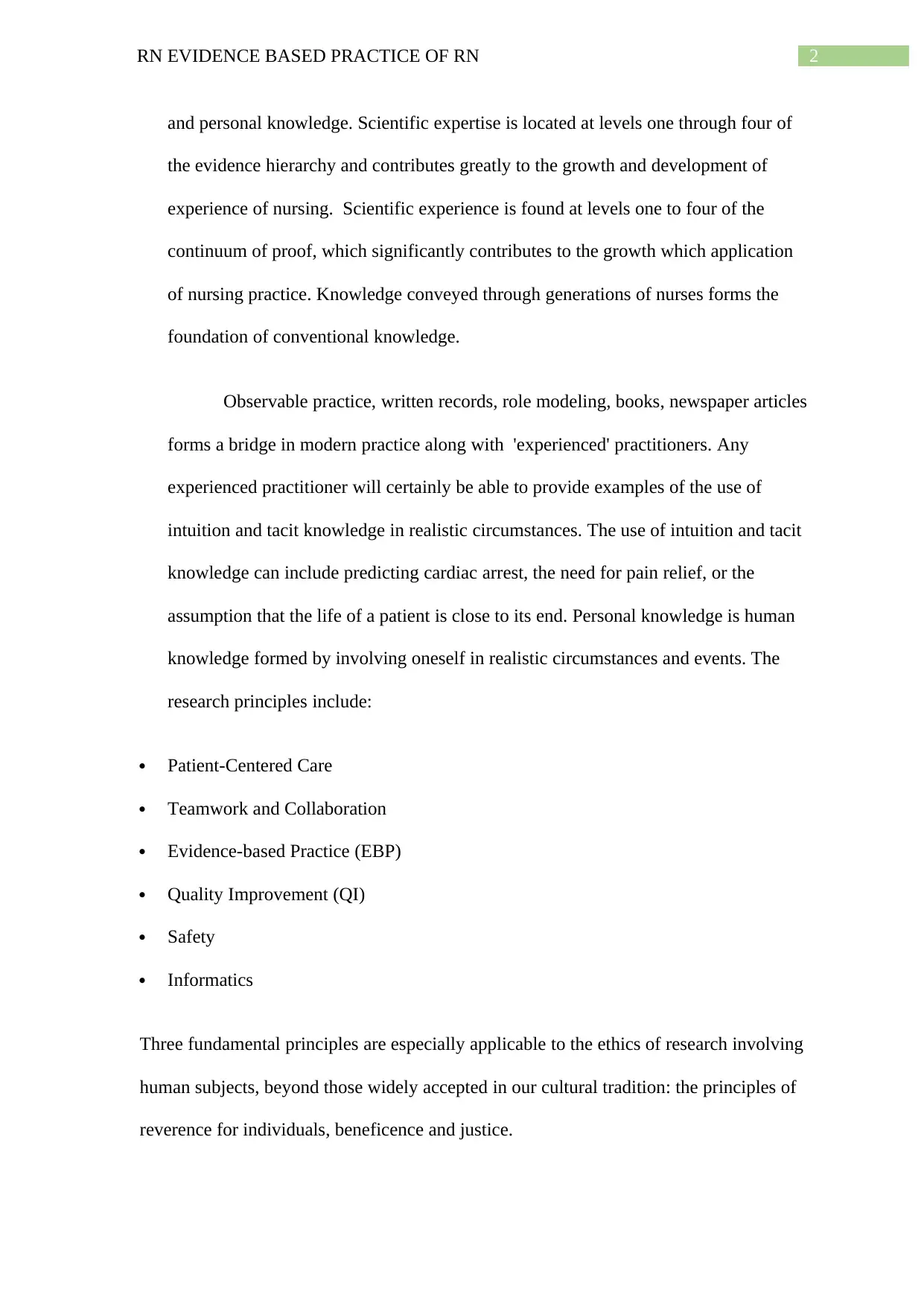
2RN EVIDENCE BASED PRACTICE OF RN
and personal knowledge. Scientific expertise is located at levels one through four of
the evidence hierarchy and contributes greatly to the growth and development of
experience of nursing. Scientific experience is found at levels one to four of the
continuum of proof, which significantly contributes to the growth which application
of nursing practice. Knowledge conveyed through generations of nurses forms the
foundation of conventional knowledge.
Observable practice, written records, role modeling, books, newspaper articles
forms a bridge in modern practice along with 'experienced' practitioners. Any
experienced practitioner will certainly be able to provide examples of the use of
intuition and tacit knowledge in realistic circumstances. The use of intuition and tacit
knowledge can include predicting cardiac arrest, the need for pain relief, or the
assumption that the life of a patient is close to its end. Personal knowledge is human
knowledge formed by involving oneself in realistic circumstances and events. The
research principles include:
Patient-Centered Care
Teamwork and Collaboration
Evidence-based Practice (EBP)
Quality Improvement (QI)
Safety
Informatics
Three fundamental principles are especially applicable to the ethics of research involving
human subjects, beyond those widely accepted in our cultural tradition: the principles of
reverence for individuals, beneficence and justice.
and personal knowledge. Scientific expertise is located at levels one through four of
the evidence hierarchy and contributes greatly to the growth and development of
experience of nursing. Scientific experience is found at levels one to four of the
continuum of proof, which significantly contributes to the growth which application
of nursing practice. Knowledge conveyed through generations of nurses forms the
foundation of conventional knowledge.
Observable practice, written records, role modeling, books, newspaper articles
forms a bridge in modern practice along with 'experienced' practitioners. Any
experienced practitioner will certainly be able to provide examples of the use of
intuition and tacit knowledge in realistic circumstances. The use of intuition and tacit
knowledge can include predicting cardiac arrest, the need for pain relief, or the
assumption that the life of a patient is close to its end. Personal knowledge is human
knowledge formed by involving oneself in realistic circumstances and events. The
research principles include:
Patient-Centered Care
Teamwork and Collaboration
Evidence-based Practice (EBP)
Quality Improvement (QI)
Safety
Informatics
Three fundamental principles are especially applicable to the ethics of research involving
human subjects, beyond those widely accepted in our cultural tradition: the principles of
reverence for individuals, beneficence and justice.
⊘ This is a preview!⊘
Do you want full access?
Subscribe today to unlock all pages.

Trusted by 1+ million students worldwide
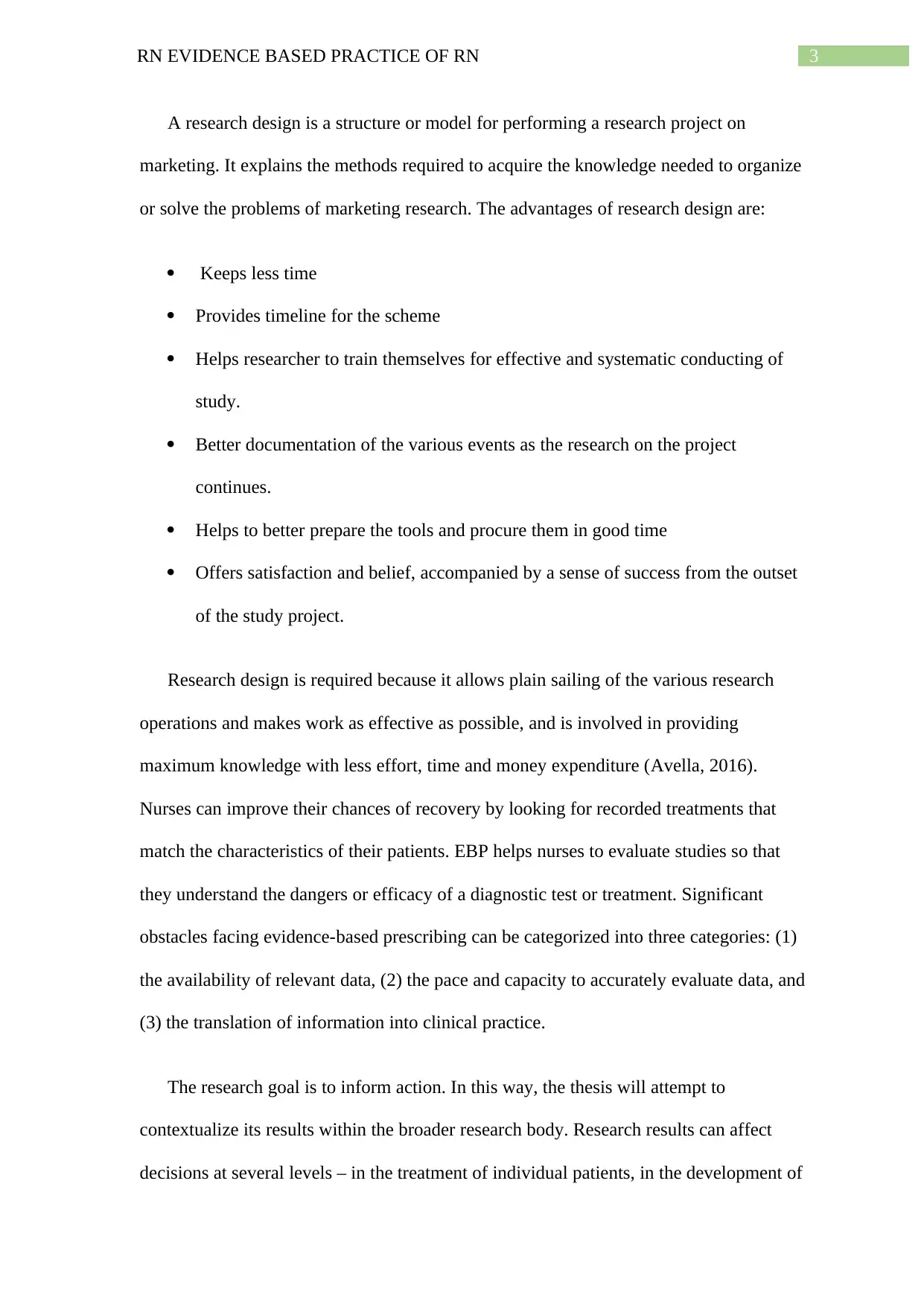
3RN EVIDENCE BASED PRACTICE OF RN
A research design is a structure or model for performing a research project on
marketing. It explains the methods required to acquire the knowledge needed to organize
or solve the problems of marketing research. The advantages of research design are:
Keeps less time
Provides timeline for the scheme
Helps researcher to train themselves for effective and systematic conducting of
study.
Better documentation of the various events as the research on the project
continues.
Helps to better prepare the tools and procure them in good time
Offers satisfaction and belief, accompanied by a sense of success from the outset
of the study project.
Research design is required because it allows plain sailing of the various research
operations and makes work as effective as possible, and is involved in providing
maximum knowledge with less effort, time and money expenditure (Avella, 2016).
Nurses can improve their chances of recovery by looking for recorded treatments that
match the characteristics of their patients. EBP helps nurses to evaluate studies so that
they understand the dangers or efficacy of a diagnostic test or treatment. Significant
obstacles facing evidence-based prescribing can be categorized into three categories: (1)
the availability of relevant data, (2) the pace and capacity to accurately evaluate data, and
(3) the translation of information into clinical practice.
The research goal is to inform action. In this way, the thesis will attempt to
contextualize its results within the broader research body. Research results can affect
decisions at several levels – in the treatment of individual patients, in the development of
A research design is a structure or model for performing a research project on
marketing. It explains the methods required to acquire the knowledge needed to organize
or solve the problems of marketing research. The advantages of research design are:
Keeps less time
Provides timeline for the scheme
Helps researcher to train themselves for effective and systematic conducting of
study.
Better documentation of the various events as the research on the project
continues.
Helps to better prepare the tools and procure them in good time
Offers satisfaction and belief, accompanied by a sense of success from the outset
of the study project.
Research design is required because it allows plain sailing of the various research
operations and makes work as effective as possible, and is involved in providing
maximum knowledge with less effort, time and money expenditure (Avella, 2016).
Nurses can improve their chances of recovery by looking for recorded treatments that
match the characteristics of their patients. EBP helps nurses to evaluate studies so that
they understand the dangers or efficacy of a diagnostic test or treatment. Significant
obstacles facing evidence-based prescribing can be categorized into three categories: (1)
the availability of relevant data, (2) the pace and capacity to accurately evaluate data, and
(3) the translation of information into clinical practice.
The research goal is to inform action. In this way, the thesis will attempt to
contextualize its results within the broader research body. Research results can affect
decisions at several levels – in the treatment of individual patients, in the development of
Paraphrase This Document
Need a fresh take? Get an instant paraphrase of this document with our AI Paraphraser
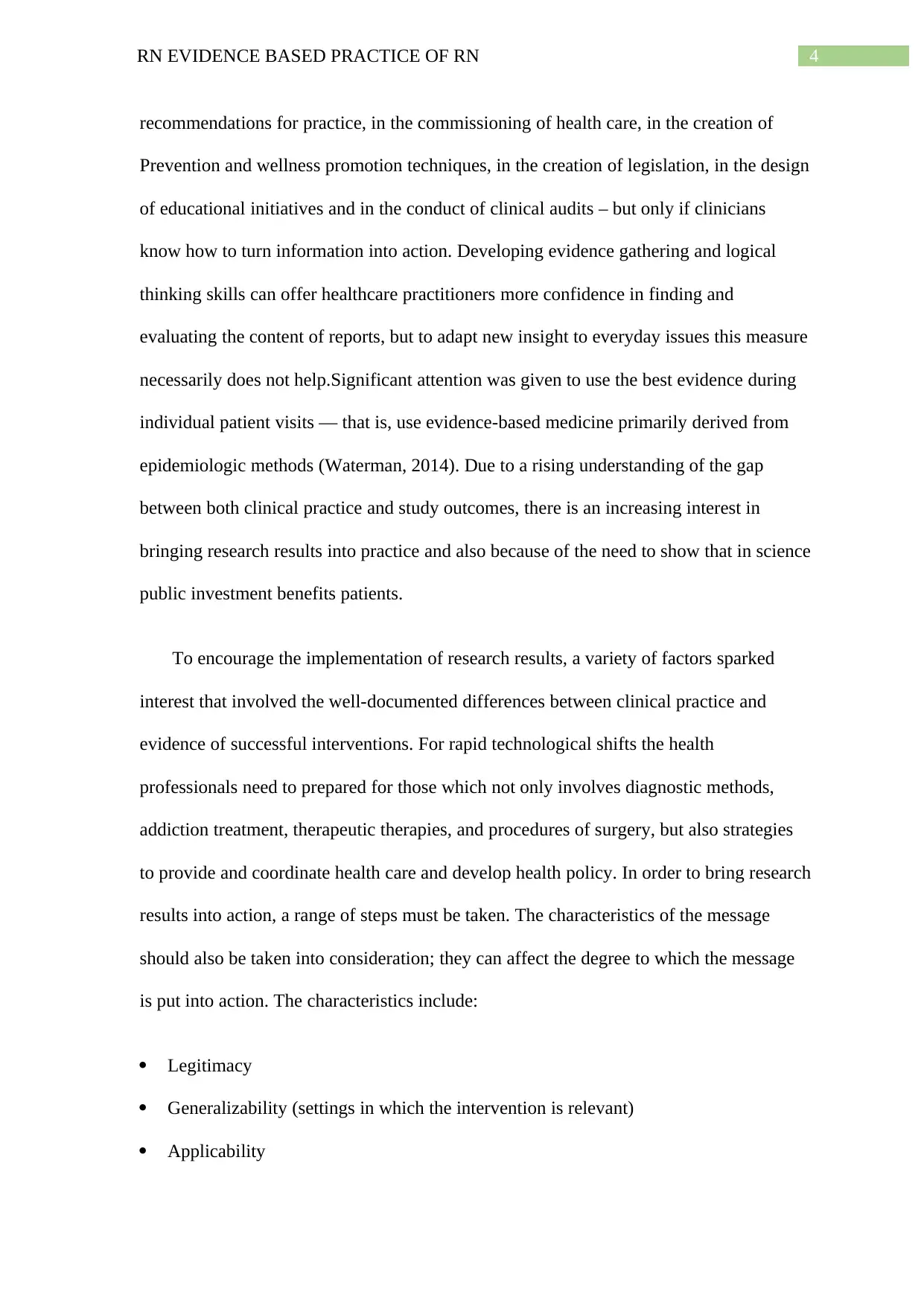
4RN EVIDENCE BASED PRACTICE OF RN
recommendations for practice, in the commissioning of health care, in the creation of
Prevention and wellness promotion techniques, in the creation of legislation, in the design
of educational initiatives and in the conduct of clinical audits – but only if clinicians
know how to turn information into action. Developing evidence gathering and logical
thinking skills can offer healthcare practitioners more confidence in finding and
evaluating the content of reports, but to adapt new insight to everyday issues this measure
necessarily does not help.Significant attention was given to use the best evidence during
individual patient visits — that is, use evidence-based medicine primarily derived from
epidemiologic methods (Waterman, 2014). Due to a rising understanding of the gap
between both clinical practice and study outcomes, there is an increasing interest in
bringing research results into practice and also because of the need to show that in science
public investment benefits patients.
To encourage the implementation of research results, a variety of factors sparked
interest that involved the well-documented differences between clinical practice and
evidence of successful interventions. For rapid technological shifts the health
professionals need to prepared for those which not only involves diagnostic methods,
addiction treatment, therapeutic therapies, and procedures of surgery, but also strategies
to provide and coordinate health care and develop health policy. In order to bring research
results into action, a range of steps must be taken. The characteristics of the message
should also be taken into consideration; they can affect the degree to which the message
is put into action. The characteristics include:
Legitimacy
Generalizability (settings in which the intervention is relevant)
Applicability
recommendations for practice, in the commissioning of health care, in the creation of
Prevention and wellness promotion techniques, in the creation of legislation, in the design
of educational initiatives and in the conduct of clinical audits – but only if clinicians
know how to turn information into action. Developing evidence gathering and logical
thinking skills can offer healthcare practitioners more confidence in finding and
evaluating the content of reports, but to adapt new insight to everyday issues this measure
necessarily does not help.Significant attention was given to use the best evidence during
individual patient visits — that is, use evidence-based medicine primarily derived from
epidemiologic methods (Waterman, 2014). Due to a rising understanding of the gap
between both clinical practice and study outcomes, there is an increasing interest in
bringing research results into practice and also because of the need to show that in science
public investment benefits patients.
To encourage the implementation of research results, a variety of factors sparked
interest that involved the well-documented differences between clinical practice and
evidence of successful interventions. For rapid technological shifts the health
professionals need to prepared for those which not only involves diagnostic methods,
addiction treatment, therapeutic therapies, and procedures of surgery, but also strategies
to provide and coordinate health care and develop health policy. In order to bring research
results into action, a range of steps must be taken. The characteristics of the message
should also be taken into consideration; they can affect the degree to which the message
is put into action. The characteristics include:
Legitimacy
Generalizability (settings in which the intervention is relevant)
Applicability
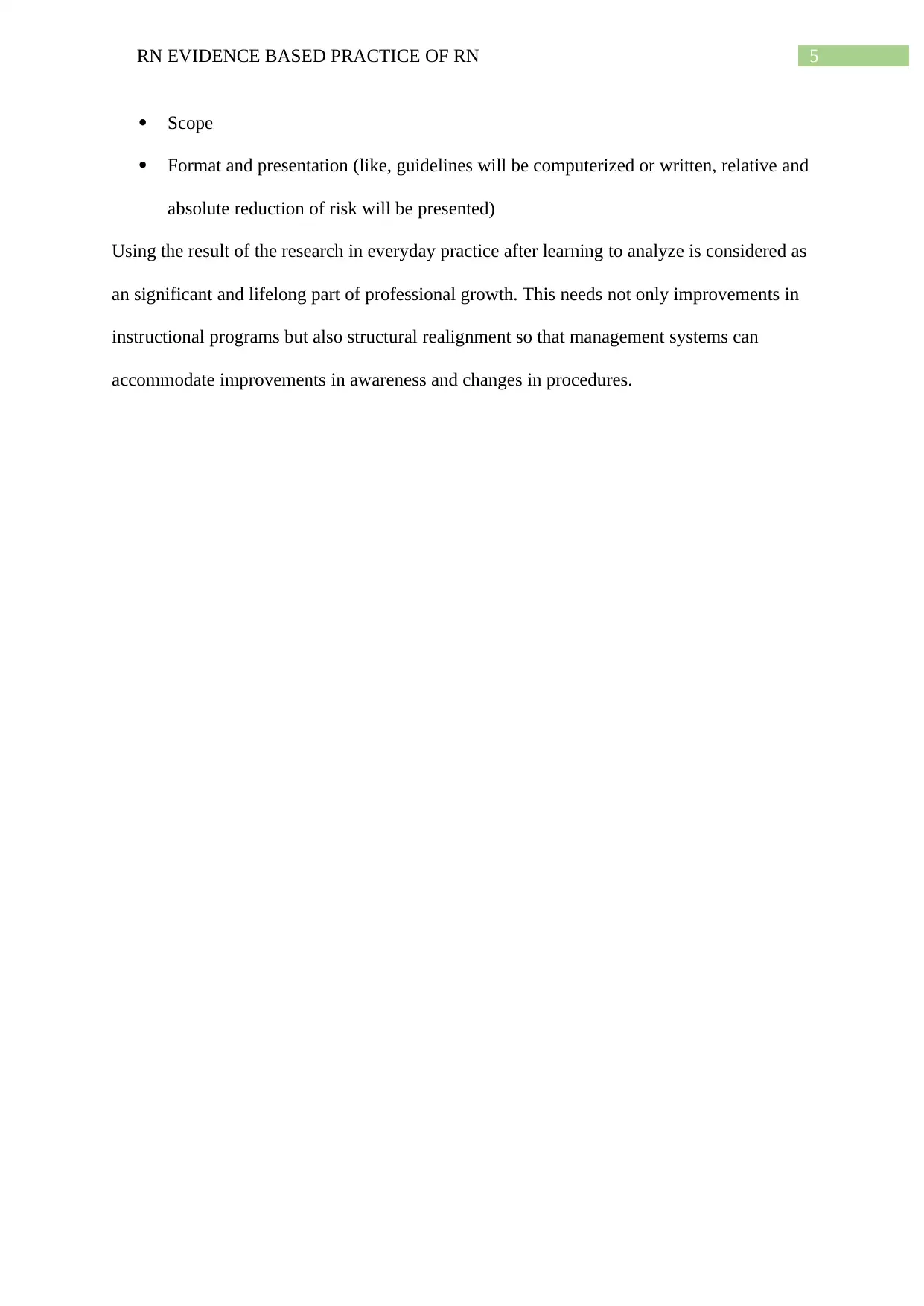
5RN EVIDENCE BASED PRACTICE OF RN
Scope
Format and presentation (like, guidelines will be computerized or written, relative and
absolute reduction of risk will be presented)
Using the result of the research in everyday practice after learning to analyze is considered as
an significant and lifelong part of professional growth. This needs not only improvements in
instructional programs but also structural realignment so that management systems can
accommodate improvements in awareness and changes in procedures.
Scope
Format and presentation (like, guidelines will be computerized or written, relative and
absolute reduction of risk will be presented)
Using the result of the research in everyday practice after learning to analyze is considered as
an significant and lifelong part of professional growth. This needs not only improvements in
instructional programs but also structural realignment so that management systems can
accommodate improvements in awareness and changes in procedures.
⊘ This is a preview!⊘
Do you want full access?
Subscribe today to unlock all pages.

Trusted by 1+ million students worldwide
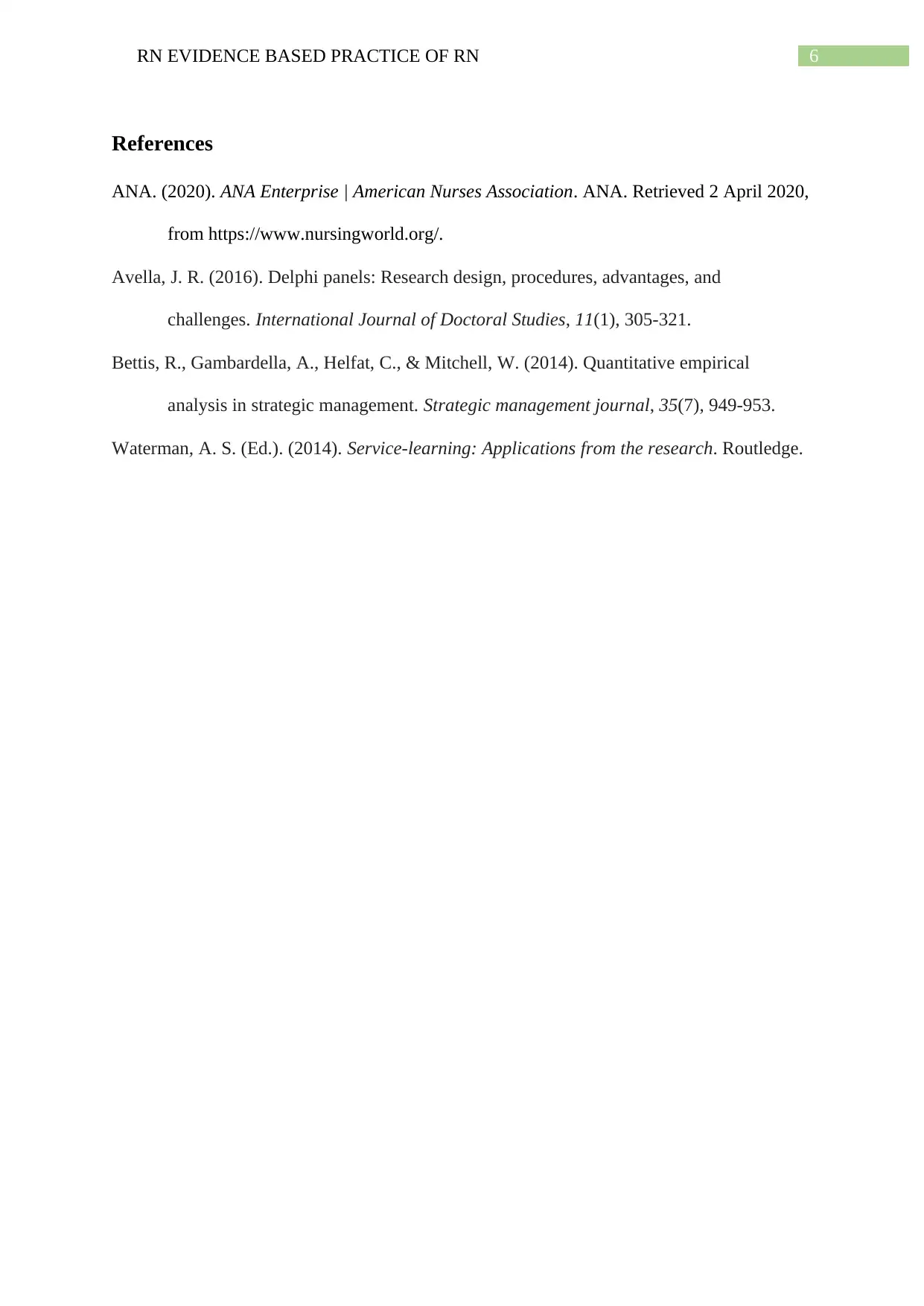
6RN EVIDENCE BASED PRACTICE OF RN
References
ANA. (2020). ANA Enterprise | American Nurses Association. ANA. Retrieved 2 April 2020,
from https://www.nursingworld.org/.
Avella, J. R. (2016). Delphi panels: Research design, procedures, advantages, and
challenges. International Journal of Doctoral Studies, 11(1), 305-321.
Bettis, R., Gambardella, A., Helfat, C., & Mitchell, W. (2014). Quantitative empirical
analysis in strategic management. Strategic management journal, 35(7), 949-953.
Waterman, A. S. (Ed.). (2014). Service-learning: Applications from the research. Routledge.
References
ANA. (2020). ANA Enterprise | American Nurses Association. ANA. Retrieved 2 April 2020,
from https://www.nursingworld.org/.
Avella, J. R. (2016). Delphi panels: Research design, procedures, advantages, and
challenges. International Journal of Doctoral Studies, 11(1), 305-321.
Bettis, R., Gambardella, A., Helfat, C., & Mitchell, W. (2014). Quantitative empirical
analysis in strategic management. Strategic management journal, 35(7), 949-953.
Waterman, A. S. (Ed.). (2014). Service-learning: Applications from the research. Routledge.
1 out of 7
Related Documents
Your All-in-One AI-Powered Toolkit for Academic Success.
+13062052269
info@desklib.com
Available 24*7 on WhatsApp / Email
![[object Object]](/_next/static/media/star-bottom.7253800d.svg)
Unlock your academic potential
Copyright © 2020–2025 A2Z Services. All Rights Reserved. Developed and managed by ZUCOL.





